Contemporary Tourism and Accommodation Issues in India Report
VerifiedAdded on 2020/05/16
|18
|4171
|59
Report
AI Summary
This report provides a comprehensive analysis of contemporary tourism and accommodation issues in India. It begins by outlining the significance of tourism for India's economic development, followed by an identification of key challenges such as inadequate infrastructure, poor marketing strategies, and safety concerns. The report then explores the emerging food and beverage market segment, highlighting its potential for growth and contribution to the tourism sector. It examines the influence of transport development on tourism growth, emphasizing the need for infrastructure improvements. Current trends in accommodation development, including the rise of micro-markets and the expansion of hotel brands, are also discussed. Furthermore, the report identifies various crisis types, including natural disasters and terrorism, and their impact on the tourism industry. The report concludes by discussing the influence of social media on marketing and the potential of two contemporary visitor experience sectors for India, providing a holistic view of the tourism landscape.
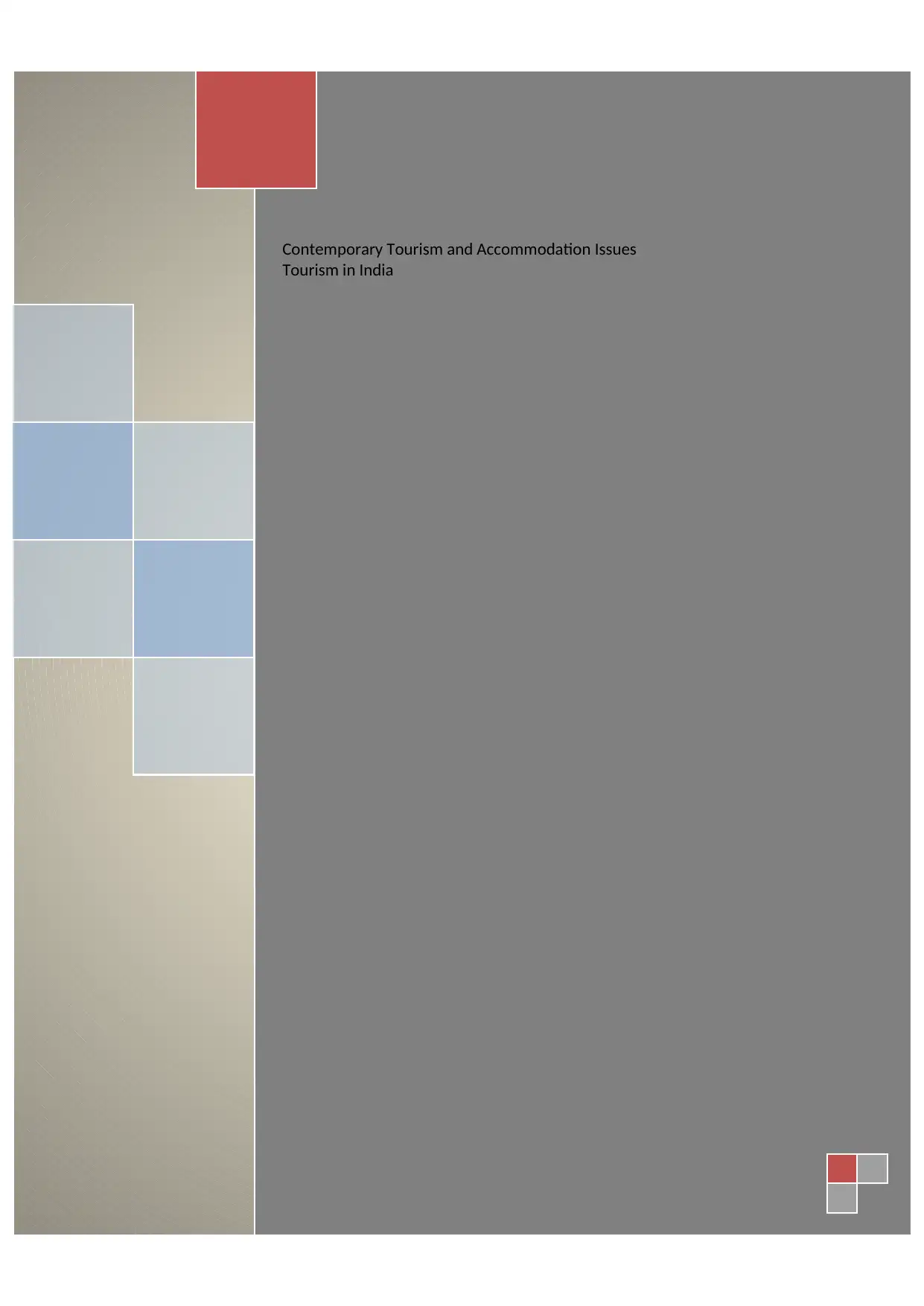
Contemporary Tourism and Accommodation Issues
Tourism in India
Tourism in India
Paraphrase This Document
Need a fresh take? Get an instant paraphrase of this document with our AI Paraphraser
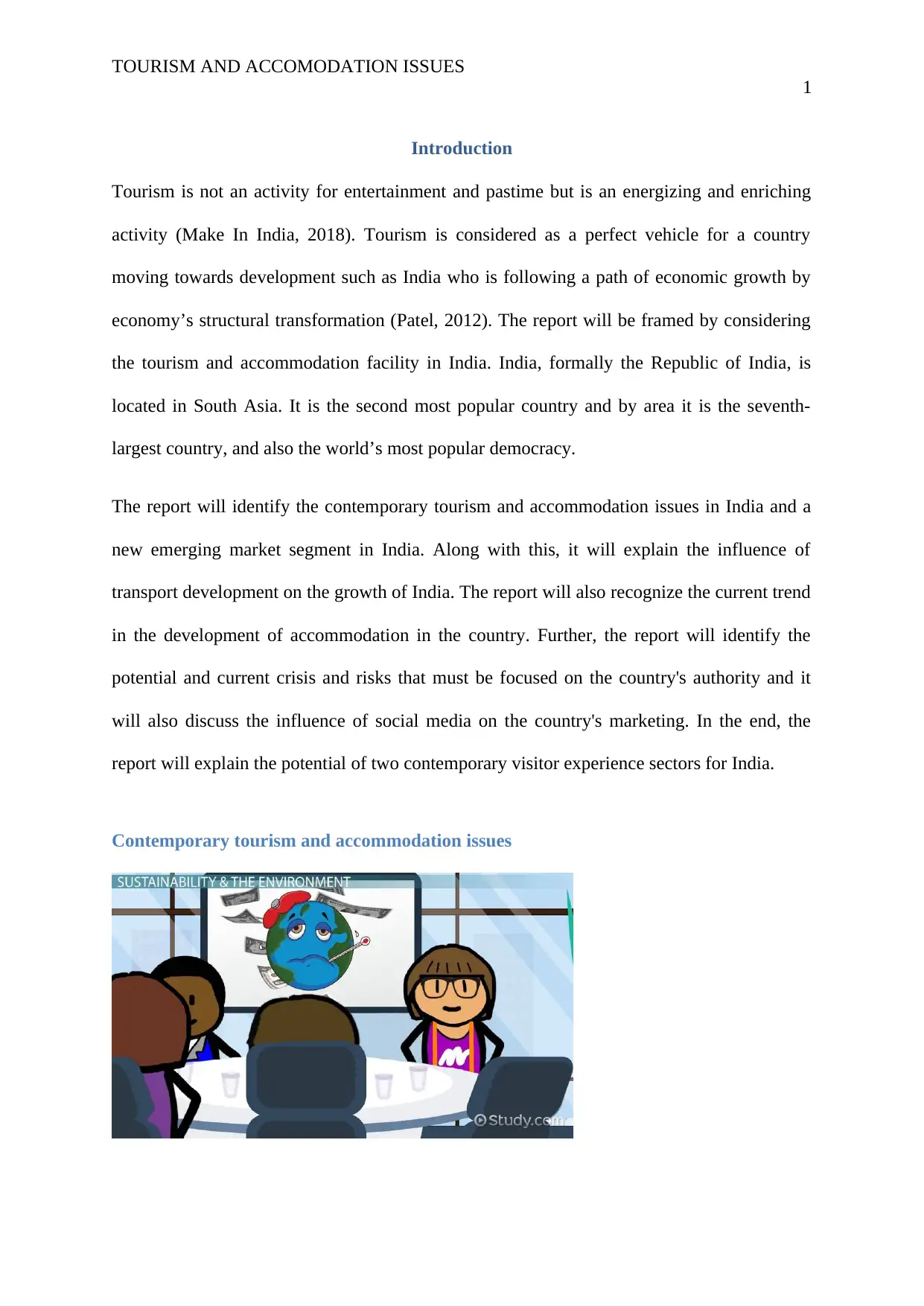
TOURISM AND ACCOMODATION ISSUES
1
Introduction
Tourism is not an activity for entertainment and pastime but is an energizing and enriching
activity (Make In India, 2018). Tourism is considered as a perfect vehicle for a country
moving towards development such as India who is following a path of economic growth by
economy’s structural transformation (Patel, 2012). The report will be framed by considering
the tourism and accommodation facility in India. India, formally the Republic of India, is
located in South Asia. It is the second most popular country and by area it is the seventh-
largest country, and also the world’s most popular democracy.
The report will identify the contemporary tourism and accommodation issues in India and a
new emerging market segment in India. Along with this, it will explain the influence of
transport development on the growth of India. The report will also recognize the current trend
in the development of accommodation in the country. Further, the report will identify the
potential and current crisis and risks that must be focused on the country's authority and it
will also discuss the influence of social media on the country's marketing. In the end, the
report will explain the potential of two contemporary visitor experience sectors for India.
Contemporary tourism and accommodation issues
1
Introduction
Tourism is not an activity for entertainment and pastime but is an energizing and enriching
activity (Make In India, 2018). Tourism is considered as a perfect vehicle for a country
moving towards development such as India who is following a path of economic growth by
economy’s structural transformation (Patel, 2012). The report will be framed by considering
the tourism and accommodation facility in India. India, formally the Republic of India, is
located in South Asia. It is the second most popular country and by area it is the seventh-
largest country, and also the world’s most popular democracy.
The report will identify the contemporary tourism and accommodation issues in India and a
new emerging market segment in India. Along with this, it will explain the influence of
transport development on the growth of India. The report will also recognize the current trend
in the development of accommodation in the country. Further, the report will identify the
potential and current crisis and risks that must be focused on the country's authority and it
will also discuss the influence of social media on the country's marketing. In the end, the
report will explain the potential of two contemporary visitor experience sectors for India.
Contemporary tourism and accommodation issues
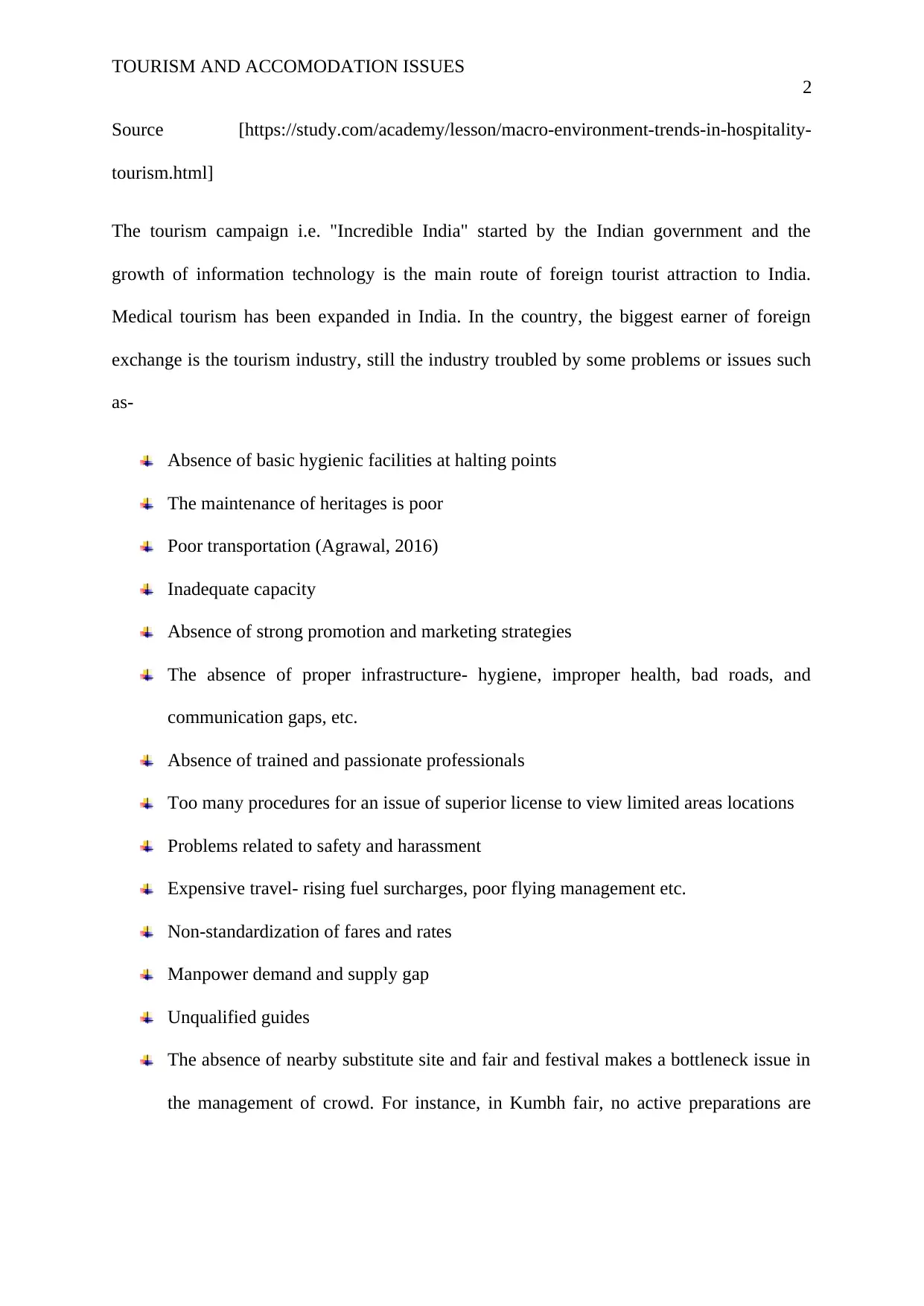
TOURISM AND ACCOMODATION ISSUES
2
Source [https://study.com/academy/lesson/macro-environment-trends-in-hospitality-
tourism.html]
The tourism campaign i.e. "Incredible India" started by the Indian government and the
growth of information technology is the main route of foreign tourist attraction to India.
Medical tourism has been expanded in India. In the country, the biggest earner of foreign
exchange is the tourism industry, still the industry troubled by some problems or issues such
as-
Absence of basic hygienic facilities at halting points
The maintenance of heritages is poor
Poor transportation (Agrawal, 2016)
Inadequate capacity
Absence of strong promotion and marketing strategies
The absence of proper infrastructure- hygiene, improper health, bad roads, and
communication gaps, etc.
Absence of trained and passionate professionals
Too many procedures for an issue of superior license to view limited areas locations
Problems related to safety and harassment
Expensive travel- rising fuel surcharges, poor flying management etc.
Non-standardization of fares and rates
Manpower demand and supply gap
Unqualified guides
The absence of nearby substitute site and fair and festival makes a bottleneck issue in
the management of crowd. For instance, in Kumbh fair, no active preparations are
2
Source [https://study.com/academy/lesson/macro-environment-trends-in-hospitality-
tourism.html]
The tourism campaign i.e. "Incredible India" started by the Indian government and the
growth of information technology is the main route of foreign tourist attraction to India.
Medical tourism has been expanded in India. In the country, the biggest earner of foreign
exchange is the tourism industry, still the industry troubled by some problems or issues such
as-
Absence of basic hygienic facilities at halting points
The maintenance of heritages is poor
Poor transportation (Agrawal, 2016)
Inadequate capacity
Absence of strong promotion and marketing strategies
The absence of proper infrastructure- hygiene, improper health, bad roads, and
communication gaps, etc.
Absence of trained and passionate professionals
Too many procedures for an issue of superior license to view limited areas locations
Problems related to safety and harassment
Expensive travel- rising fuel surcharges, poor flying management etc.
Non-standardization of fares and rates
Manpower demand and supply gap
Unqualified guides
The absence of nearby substitute site and fair and festival makes a bottleneck issue in
the management of crowd. For instance, in Kumbh fair, no active preparations are
⊘ This is a preview!⊘
Do you want full access?
Subscribe today to unlock all pages.

Trusted by 1+ million students worldwide
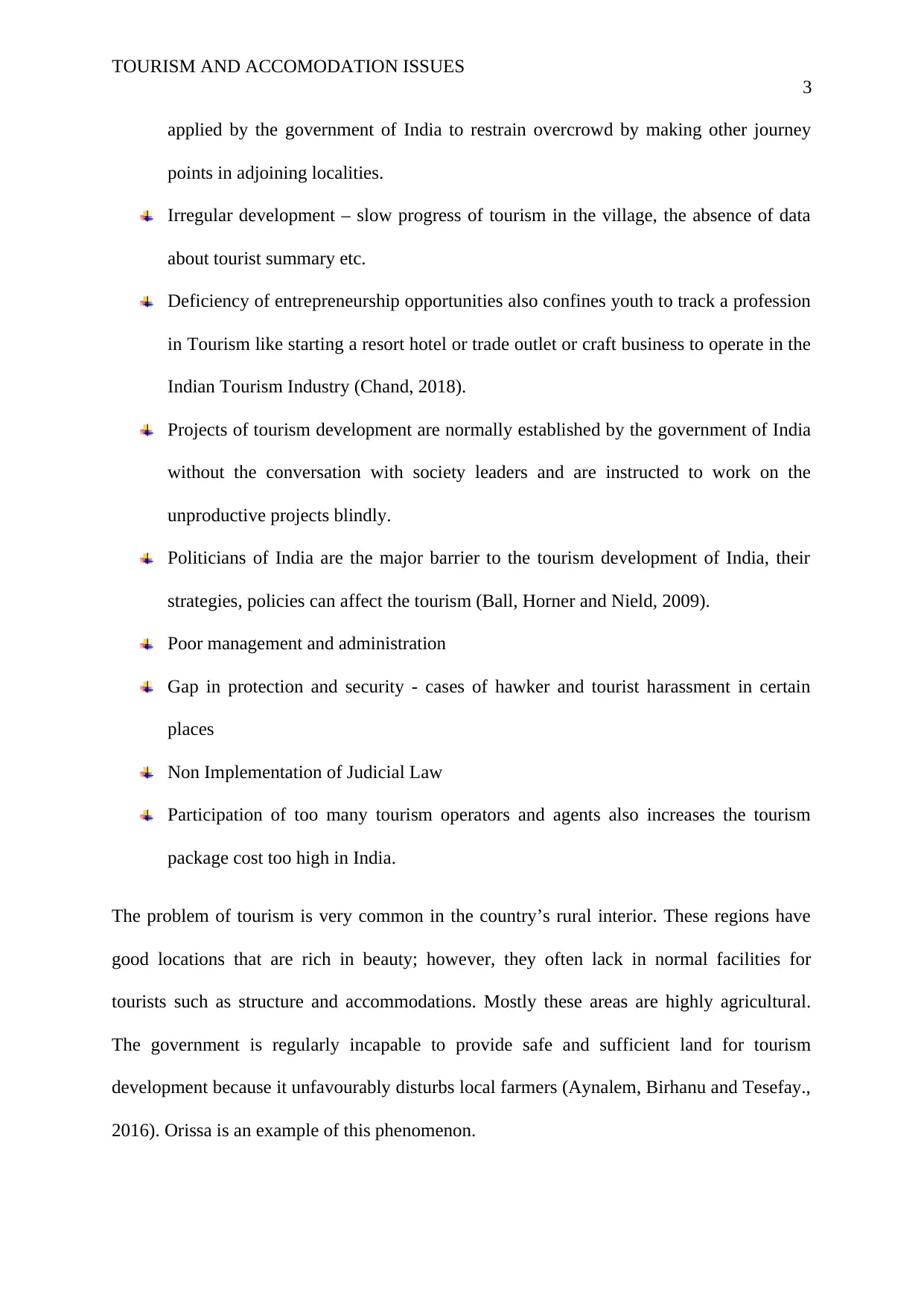
TOURISM AND ACCOMODATION ISSUES
3
applied by the government of India to restrain overcrowd by making other journey
points in adjoining localities.
Irregular development – slow progress of tourism in the village, the absence of data
about tourist summary etc.
Deficiency of entrepreneurship opportunities also confines youth to track a profession
in Tourism like starting a resort hotel or trade outlet or craft business to operate in the
Indian Tourism Industry (Chand, 2018).
Projects of tourism development are normally established by the government of India
without the conversation with society leaders and are instructed to work on the
unproductive projects blindly.
Politicians of India are the major barrier to the tourism development of India, their
strategies, policies can affect the tourism (Ball, Horner and Nield, 2009).
Poor management and administration
Gap in protection and security - cases of hawker and tourist harassment in certain
places
Non Implementation of Judicial Law
Participation of too many tourism operators and agents also increases the tourism
package cost too high in India.
The problem of tourism is very common in the country’s rural interior. These regions have
good locations that are rich in beauty; however, they often lack in normal facilities for
tourists such as structure and accommodations. Mostly these areas are highly agricultural.
The government is regularly incapable to provide safe and sufficient land for tourism
development because it unfavourably disturbs local farmers (Aynalem, Birhanu and Tesefay.,
2016). Orissa is an example of this phenomenon.
3
applied by the government of India to restrain overcrowd by making other journey
points in adjoining localities.
Irregular development – slow progress of tourism in the village, the absence of data
about tourist summary etc.
Deficiency of entrepreneurship opportunities also confines youth to track a profession
in Tourism like starting a resort hotel or trade outlet or craft business to operate in the
Indian Tourism Industry (Chand, 2018).
Projects of tourism development are normally established by the government of India
without the conversation with society leaders and are instructed to work on the
unproductive projects blindly.
Politicians of India are the major barrier to the tourism development of India, their
strategies, policies can affect the tourism (Ball, Horner and Nield, 2009).
Poor management and administration
Gap in protection and security - cases of hawker and tourist harassment in certain
places
Non Implementation of Judicial Law
Participation of too many tourism operators and agents also increases the tourism
package cost too high in India.
The problem of tourism is very common in the country’s rural interior. These regions have
good locations that are rich in beauty; however, they often lack in normal facilities for
tourists such as structure and accommodations. Mostly these areas are highly agricultural.
The government is regularly incapable to provide safe and sufficient land for tourism
development because it unfavourably disturbs local farmers (Aynalem, Birhanu and Tesefay.,
2016). Orissa is an example of this phenomenon.
Paraphrase This Document
Need a fresh take? Get an instant paraphrase of this document with our AI Paraphraser
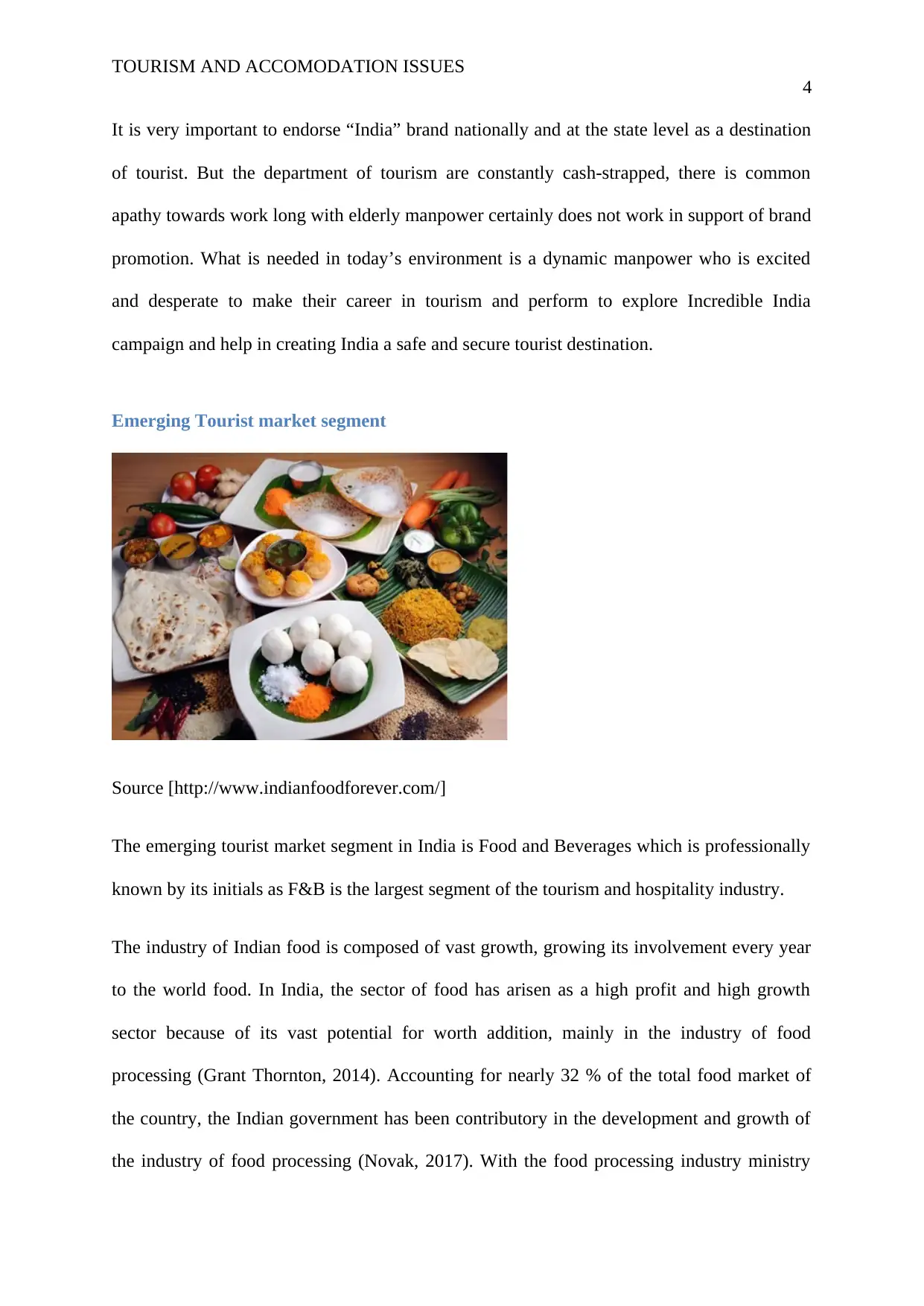
TOURISM AND ACCOMODATION ISSUES
4
It is very important to endorse “India” brand nationally and at the state level as a destination
of tourist. But the department of tourism are constantly cash-strapped, there is common
apathy towards work long with elderly manpower certainly does not work in support of brand
promotion. What is needed in today’s environment is a dynamic manpower who is excited
and desperate to make their career in tourism and perform to explore Incredible India
campaign and help in creating India a safe and secure tourist destination.
Emerging Tourist market segment
Source [http://www.indianfoodforever.com/]
The emerging tourist market segment in India is Food and Beverages which is professionally
known by its initials as F&B is the largest segment of the tourism and hospitality industry.
The industry of Indian food is composed of vast growth, growing its involvement every year
to the world food. In India, the sector of food has arisen as a high profit and high growth
sector because of its vast potential for worth addition, mainly in the industry of food
processing (Grant Thornton, 2014). Accounting for nearly 32 % of the total food market of
the country, the Indian government has been contributory in the development and growth of
the industry of food processing (Novak, 2017). With the food processing industry ministry
4
It is very important to endorse “India” brand nationally and at the state level as a destination
of tourist. But the department of tourism are constantly cash-strapped, there is common
apathy towards work long with elderly manpower certainly does not work in support of brand
promotion. What is needed in today’s environment is a dynamic manpower who is excited
and desperate to make their career in tourism and perform to explore Incredible India
campaign and help in creating India a safe and secure tourist destination.
Emerging Tourist market segment
Source [http://www.indianfoodforever.com/]
The emerging tourist market segment in India is Food and Beverages which is professionally
known by its initials as F&B is the largest segment of the tourism and hospitality industry.
The industry of Indian food is composed of vast growth, growing its involvement every year
to the world food. In India, the sector of food has arisen as a high profit and high growth
sector because of its vast potential for worth addition, mainly in the industry of food
processing (Grant Thornton, 2014). Accounting for nearly 32 % of the total food market of
the country, the Indian government has been contributory in the development and growth of
the industry of food processing (Novak, 2017). With the food processing industry ministry
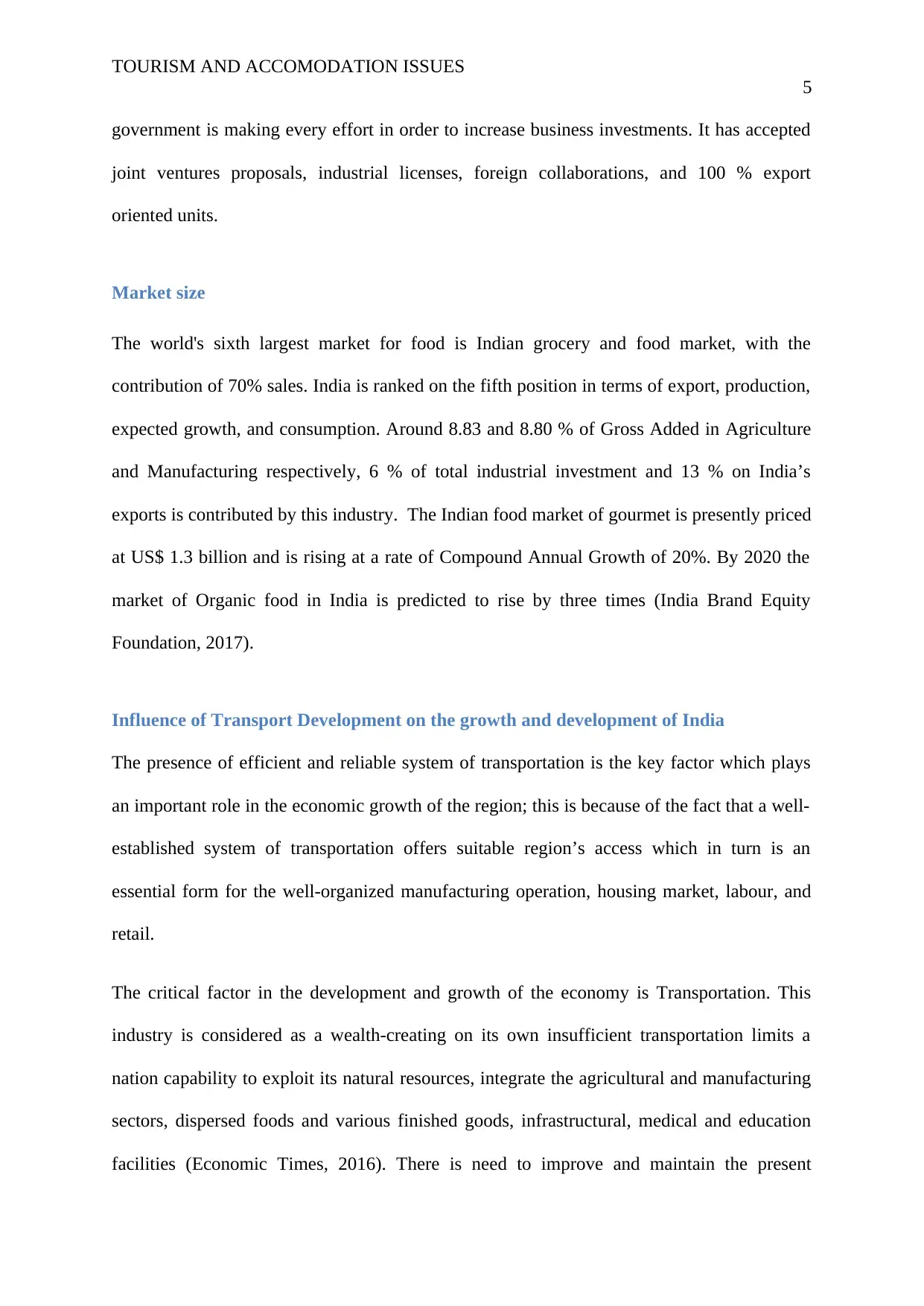
TOURISM AND ACCOMODATION ISSUES
5
government is making every effort in order to increase business investments. It has accepted
joint ventures proposals, industrial licenses, foreign collaborations, and 100 % export
oriented units.
Market size
The world's sixth largest market for food is Indian grocery and food market, with the
contribution of 70% sales. India is ranked on the fifth position in terms of export, production,
expected growth, and consumption. Around 8.83 and 8.80 % of Gross Added in Agriculture
and Manufacturing respectively, 6 % of total industrial investment and 13 % on India’s
exports is contributed by this industry. The Indian food market of gourmet is presently priced
at US$ 1.3 billion and is rising at a rate of Compound Annual Growth of 20%. By 2020 the
market of Organic food in India is predicted to rise by three times (India Brand Equity
Foundation, 2017).
Influence of Transport Development on the growth and development of India
The presence of efficient and reliable system of transportation is the key factor which plays
an important role in the economic growth of the region; this is because of the fact that a well-
established system of transportation offers suitable region’s access which in turn is an
essential form for the well-organized manufacturing operation, housing market, labour, and
retail.
The critical factor in the development and growth of the economy is Transportation. This
industry is considered as a wealth-creating on its own insufficient transportation limits a
nation capability to exploit its natural resources, integrate the agricultural and manufacturing
sectors, dispersed foods and various finished goods, infrastructural, medical and education
facilities (Economic Times, 2016). There is need to improve and maintain the present
5
government is making every effort in order to increase business investments. It has accepted
joint ventures proposals, industrial licenses, foreign collaborations, and 100 % export
oriented units.
Market size
The world's sixth largest market for food is Indian grocery and food market, with the
contribution of 70% sales. India is ranked on the fifth position in terms of export, production,
expected growth, and consumption. Around 8.83 and 8.80 % of Gross Added in Agriculture
and Manufacturing respectively, 6 % of total industrial investment and 13 % on India’s
exports is contributed by this industry. The Indian food market of gourmet is presently priced
at US$ 1.3 billion and is rising at a rate of Compound Annual Growth of 20%. By 2020 the
market of Organic food in India is predicted to rise by three times (India Brand Equity
Foundation, 2017).
Influence of Transport Development on the growth and development of India
The presence of efficient and reliable system of transportation is the key factor which plays
an important role in the economic growth of the region; this is because of the fact that a well-
established system of transportation offers suitable region’s access which in turn is an
essential form for the well-organized manufacturing operation, housing market, labour, and
retail.
The critical factor in the development and growth of the economy is Transportation. This
industry is considered as a wealth-creating on its own insufficient transportation limits a
nation capability to exploit its natural resources, integrate the agricultural and manufacturing
sectors, dispersed foods and various finished goods, infrastructural, medical and education
facilities (Economic Times, 2016). There is need to improve and maintain the present
⊘ This is a preview!⊘
Do you want full access?
Subscribe today to unlock all pages.

Trusted by 1+ million students worldwide
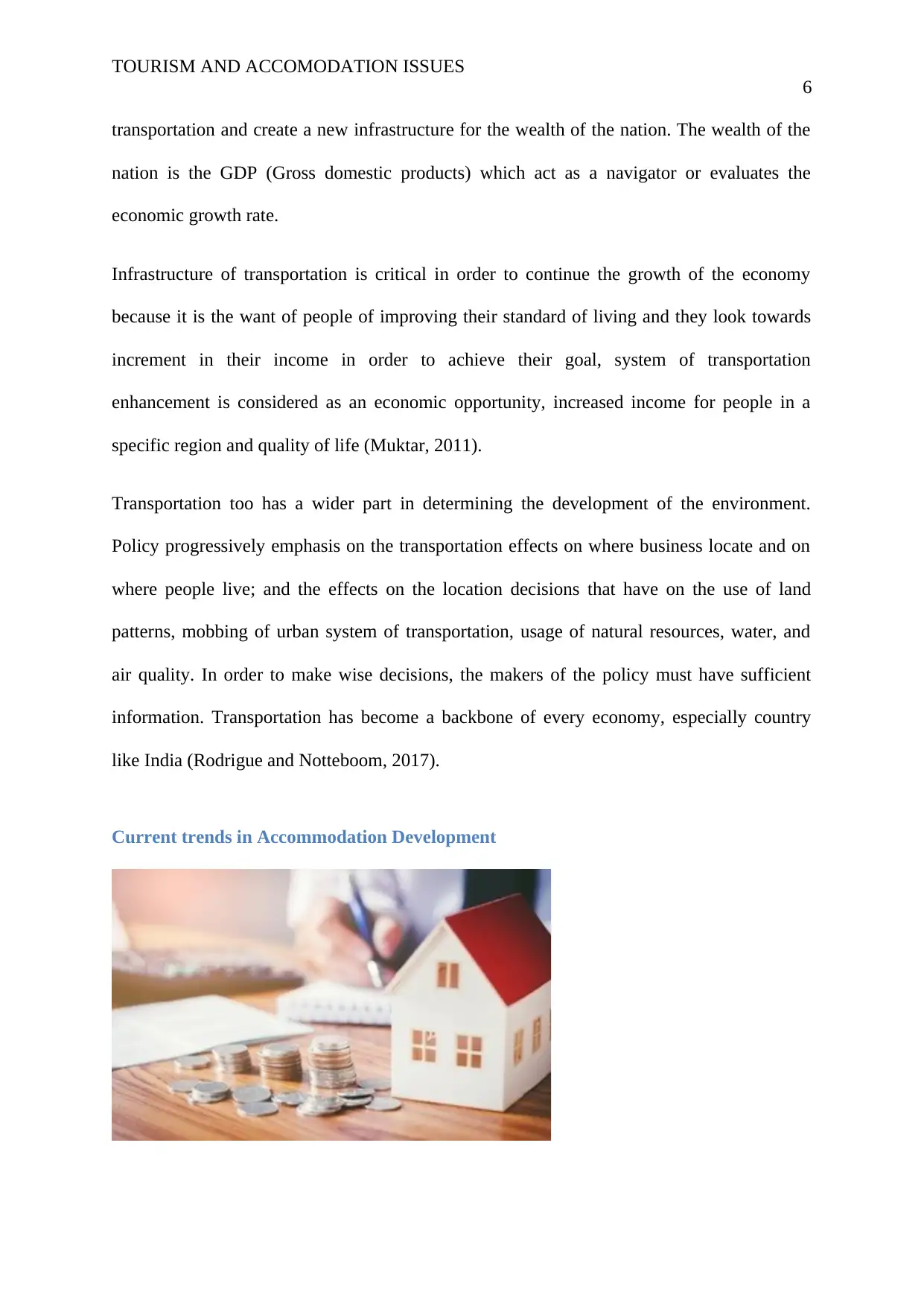
TOURISM AND ACCOMODATION ISSUES
6
transportation and create a new infrastructure for the wealth of the nation. The wealth of the
nation is the GDP (Gross domestic products) which act as a navigator or evaluates the
economic growth rate.
Infrastructure of transportation is critical in order to continue the growth of the economy
because it is the want of people of improving their standard of living and they look towards
increment in their income in order to achieve their goal, system of transportation
enhancement is considered as an economic opportunity, increased income for people in a
specific region and quality of life (Muktar, 2011).
Transportation too has a wider part in determining the development of the environment.
Policy progressively emphasis on the transportation effects on where business locate and on
where people live; and the effects on the location decisions that have on the use of land
patterns, mobbing of urban system of transportation, usage of natural resources, water, and
air quality. In order to make wise decisions, the makers of the policy must have sufficient
information. Transportation has become a backbone of every economy, especially country
like India (Rodrigue and Notteboom, 2017).
Current trends in Accommodation Development
6
transportation and create a new infrastructure for the wealth of the nation. The wealth of the
nation is the GDP (Gross domestic products) which act as a navigator or evaluates the
economic growth rate.
Infrastructure of transportation is critical in order to continue the growth of the economy
because it is the want of people of improving their standard of living and they look towards
increment in their income in order to achieve their goal, system of transportation
enhancement is considered as an economic opportunity, increased income for people in a
specific region and quality of life (Muktar, 2011).
Transportation too has a wider part in determining the development of the environment.
Policy progressively emphasis on the transportation effects on where business locate and on
where people live; and the effects on the location decisions that have on the use of land
patterns, mobbing of urban system of transportation, usage of natural resources, water, and
air quality. In order to make wise decisions, the makers of the policy must have sufficient
information. Transportation has become a backbone of every economy, especially country
like India (Rodrigue and Notteboom, 2017).
Current trends in Accommodation Development
Paraphrase This Document
Need a fresh take? Get an instant paraphrase of this document with our AI Paraphraser
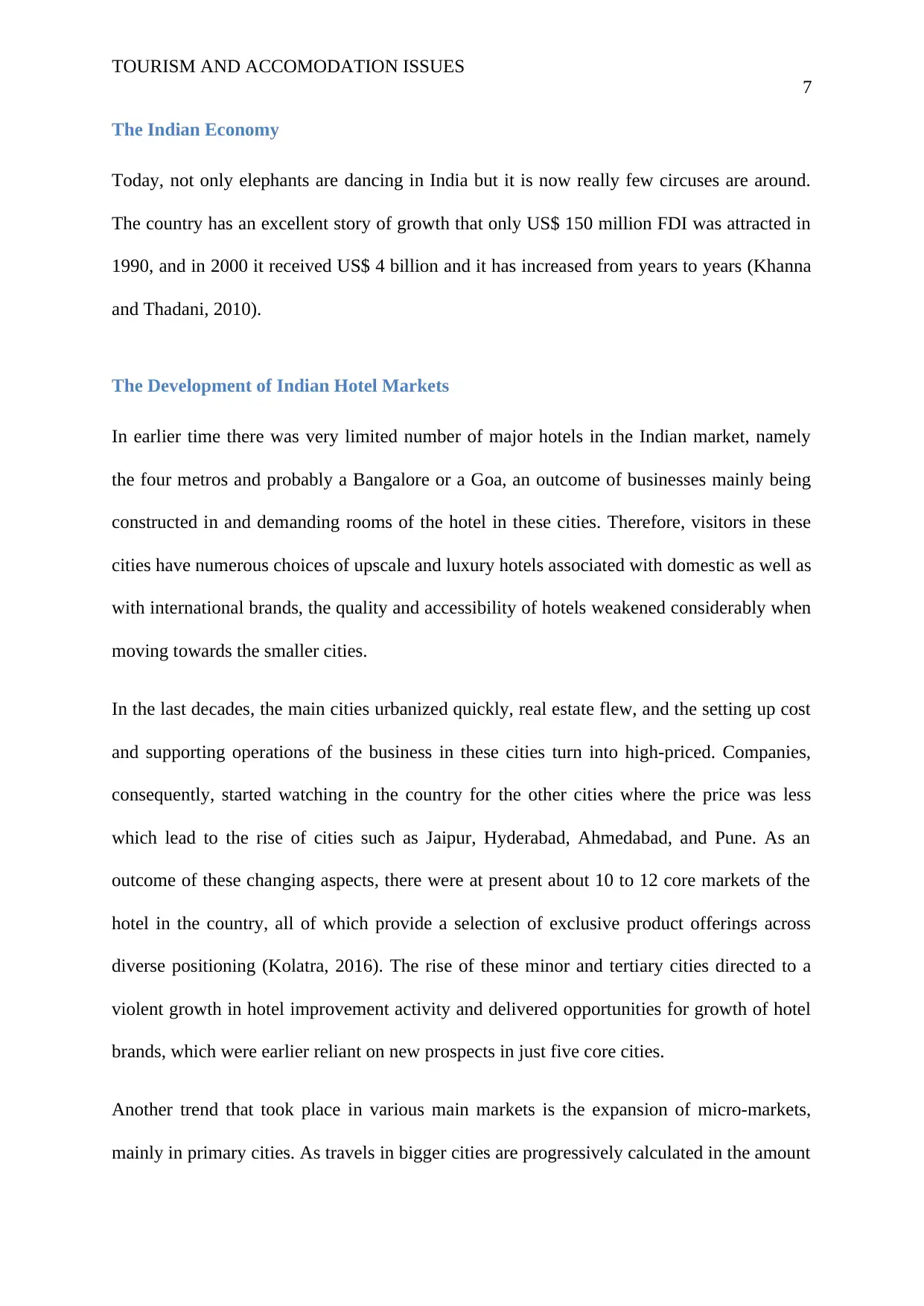
TOURISM AND ACCOMODATION ISSUES
7
The Indian Economy
Today, not only elephants are dancing in India but it is now really few circuses are around.
The country has an excellent story of growth that only US$ 150 million FDI was attracted in
1990, and in 2000 it received US$ 4 billion and it has increased from years to years (Khanna
and Thadani, 2010).
The Development of Indian Hotel Markets
In earlier time there was very limited number of major hotels in the Indian market, namely
the four metros and probably a Bangalore or a Goa, an outcome of businesses mainly being
constructed in and demanding rooms of the hotel in these cities. Therefore, visitors in these
cities have numerous choices of upscale and luxury hotels associated with domestic as well as
with international brands, the quality and accessibility of hotels weakened considerably when
moving towards the smaller cities.
In the last decades, the main cities urbanized quickly, real estate flew, and the setting up cost
and supporting operations of the business in these cities turn into high-priced. Companies,
consequently, started watching in the country for the other cities where the price was less
which lead to the rise of cities such as Jaipur, Hyderabad, Ahmedabad, and Pune. As an
outcome of these changing aspects, there were at present about 10 to 12 core markets of the
hotel in the country, all of which provide a selection of exclusive product offerings across
diverse positioning (Kolatra, 2016). The rise of these minor and tertiary cities directed to a
violent growth in hotel improvement activity and delivered opportunities for growth of hotel
brands, which were earlier reliant on new prospects in just five core cities.
Another trend that took place in various main markets is the expansion of micro-markets,
mainly in primary cities. As travels in bigger cities are progressively calculated in the amount
7
The Indian Economy
Today, not only elephants are dancing in India but it is now really few circuses are around.
The country has an excellent story of growth that only US$ 150 million FDI was attracted in
1990, and in 2000 it received US$ 4 billion and it has increased from years to years (Khanna
and Thadani, 2010).
The Development of Indian Hotel Markets
In earlier time there was very limited number of major hotels in the Indian market, namely
the four metros and probably a Bangalore or a Goa, an outcome of businesses mainly being
constructed in and demanding rooms of the hotel in these cities. Therefore, visitors in these
cities have numerous choices of upscale and luxury hotels associated with domestic as well as
with international brands, the quality and accessibility of hotels weakened considerably when
moving towards the smaller cities.
In the last decades, the main cities urbanized quickly, real estate flew, and the setting up cost
and supporting operations of the business in these cities turn into high-priced. Companies,
consequently, started watching in the country for the other cities where the price was less
which lead to the rise of cities such as Jaipur, Hyderabad, Ahmedabad, and Pune. As an
outcome of these changing aspects, there were at present about 10 to 12 core markets of the
hotel in the country, all of which provide a selection of exclusive product offerings across
diverse positioning (Kolatra, 2016). The rise of these minor and tertiary cities directed to a
violent growth in hotel improvement activity and delivered opportunities for growth of hotel
brands, which were earlier reliant on new prospects in just five core cities.
Another trend that took place in various main markets is the expansion of micro-markets,
mainly in primary cities. As travels in bigger cities are progressively calculated in the amount
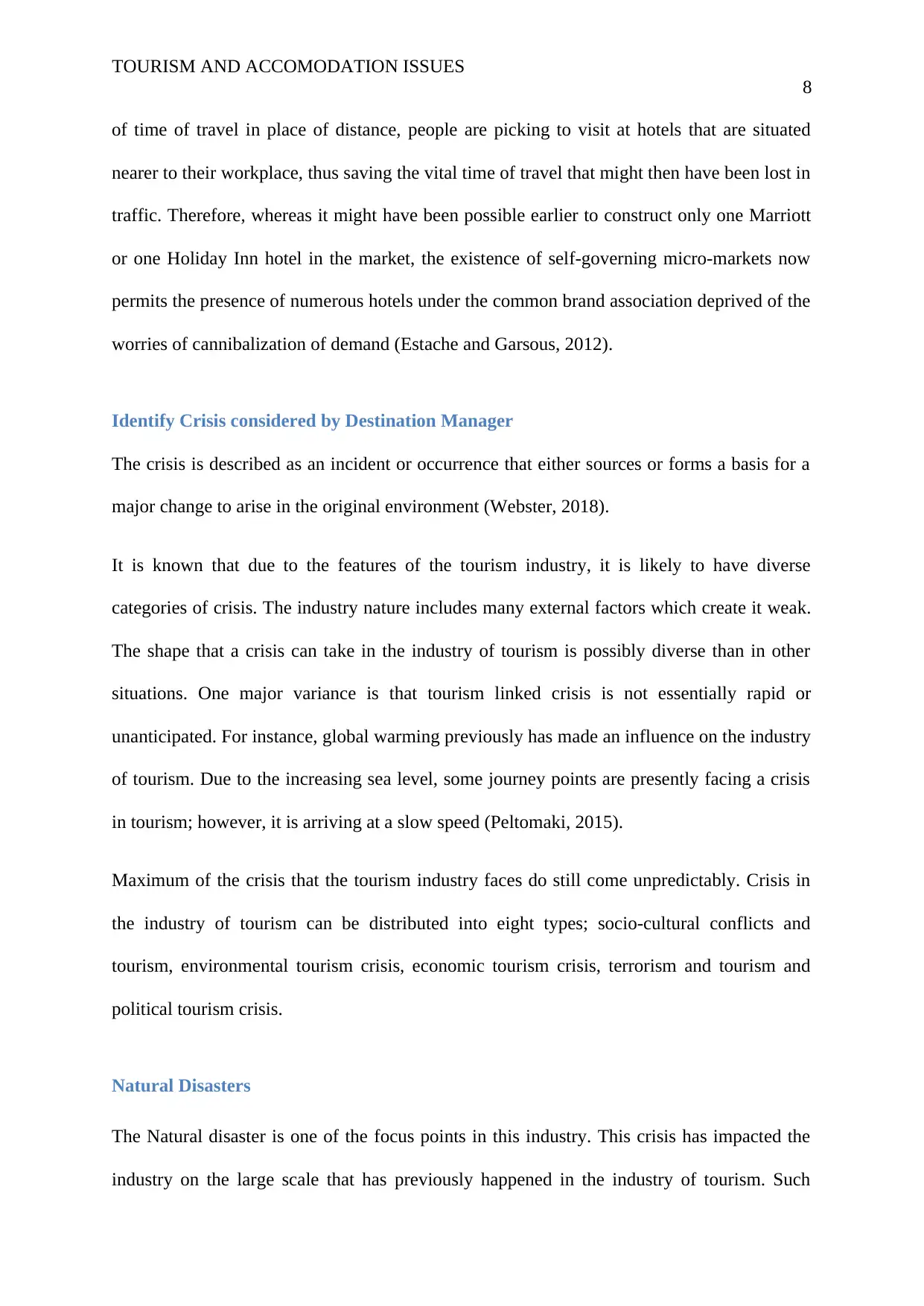
TOURISM AND ACCOMODATION ISSUES
8
of time of travel in place of distance, people are picking to visit at hotels that are situated
nearer to their workplace, thus saving the vital time of travel that might then have been lost in
traffic. Therefore, whereas it might have been possible earlier to construct only one Marriott
or one Holiday Inn hotel in the market, the existence of self-governing micro-markets now
permits the presence of numerous hotels under the common brand association deprived of the
worries of cannibalization of demand (Estache and Garsous, 2012).
Identify Crisis considered by Destination Manager
The crisis is described as an incident or occurrence that either sources or forms a basis for a
major change to arise in the original environment (Webster, 2018).
It is known that due to the features of the tourism industry, it is likely to have diverse
categories of crisis. The industry nature includes many external factors which create it weak.
The shape that a crisis can take in the industry of tourism is possibly diverse than in other
situations. One major variance is that tourism linked crisis is not essentially rapid or
unanticipated. For instance, global warming previously has made an influence on the industry
of tourism. Due to the increasing sea level, some journey points are presently facing a crisis
in tourism; however, it is arriving at a slow speed (Peltomaki, 2015).
Maximum of the crisis that the tourism industry faces do still come unpredictably. Crisis in
the industry of tourism can be distributed into eight types; socio-cultural conflicts and
tourism, environmental tourism crisis, economic tourism crisis, terrorism and tourism and
political tourism crisis.
Natural Disasters
The Natural disaster is one of the focus points in this industry. This crisis has impacted the
industry on the large scale that has previously happened in the industry of tourism. Such
8
of time of travel in place of distance, people are picking to visit at hotels that are situated
nearer to their workplace, thus saving the vital time of travel that might then have been lost in
traffic. Therefore, whereas it might have been possible earlier to construct only one Marriott
or one Holiday Inn hotel in the market, the existence of self-governing micro-markets now
permits the presence of numerous hotels under the common brand association deprived of the
worries of cannibalization of demand (Estache and Garsous, 2012).
Identify Crisis considered by Destination Manager
The crisis is described as an incident or occurrence that either sources or forms a basis for a
major change to arise in the original environment (Webster, 2018).
It is known that due to the features of the tourism industry, it is likely to have diverse
categories of crisis. The industry nature includes many external factors which create it weak.
The shape that a crisis can take in the industry of tourism is possibly diverse than in other
situations. One major variance is that tourism linked crisis is not essentially rapid or
unanticipated. For instance, global warming previously has made an influence on the industry
of tourism. Due to the increasing sea level, some journey points are presently facing a crisis
in tourism; however, it is arriving at a slow speed (Peltomaki, 2015).
Maximum of the crisis that the tourism industry faces do still come unpredictably. Crisis in
the industry of tourism can be distributed into eight types; socio-cultural conflicts and
tourism, environmental tourism crisis, economic tourism crisis, terrorism and tourism and
political tourism crisis.
Natural Disasters
The Natural disaster is one of the focus points in this industry. This crisis has impacted the
industry on the large scale that has previously happened in the industry of tourism. Such
⊘ This is a preview!⊘
Do you want full access?
Subscribe today to unlock all pages.

Trusted by 1+ million students worldwide
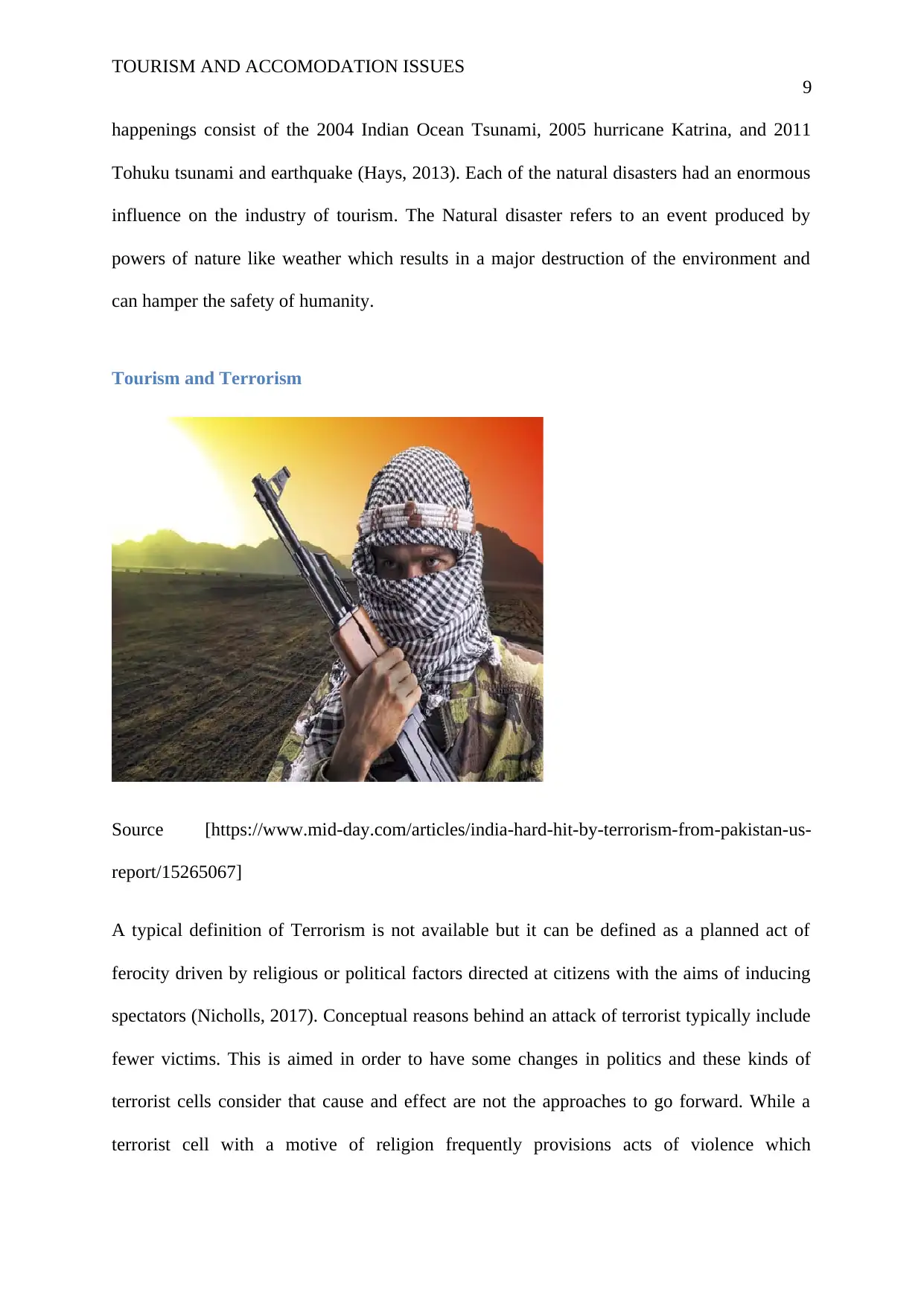
TOURISM AND ACCOMODATION ISSUES
9
happenings consist of the 2004 Indian Ocean Tsunami, 2005 hurricane Katrina, and 2011
Tohuku tsunami and earthquake (Hays, 2013). Each of the natural disasters had an enormous
influence on the industry of tourism. The Natural disaster refers to an event produced by
powers of nature like weather which results in a major destruction of the environment and
can hamper the safety of humanity.
Tourism and Terrorism
Source [https://www.mid-day.com/articles/india-hard-hit-by-terrorism-from-pakistan-us-
report/15265067]
A typical definition of Terrorism is not available but it can be defined as a planned act of
ferocity driven by religious or political factors directed at citizens with the aims of inducing
spectators (Nicholls, 2017). Conceptual reasons behind an attack of terrorist typically include
fewer victims. This is aimed in order to have some changes in politics and these kinds of
terrorist cells consider that cause and effect are not the approaches to go forward. While a
terrorist cell with a motive of religion frequently provisions acts of violence which
9
happenings consist of the 2004 Indian Ocean Tsunami, 2005 hurricane Katrina, and 2011
Tohuku tsunami and earthquake (Hays, 2013). Each of the natural disasters had an enormous
influence on the industry of tourism. The Natural disaster refers to an event produced by
powers of nature like weather which results in a major destruction of the environment and
can hamper the safety of humanity.
Tourism and Terrorism
Source [https://www.mid-day.com/articles/india-hard-hit-by-terrorism-from-pakistan-us-
report/15265067]
A typical definition of Terrorism is not available but it can be defined as a planned act of
ferocity driven by religious or political factors directed at citizens with the aims of inducing
spectators (Nicholls, 2017). Conceptual reasons behind an attack of terrorist typically include
fewer victims. This is aimed in order to have some changes in politics and these kinds of
terrorist cells consider that cause and effect are not the approaches to go forward. While a
terrorist cell with a motive of religion frequently provisions acts of violence which
Paraphrase This Document
Need a fresh take? Get an instant paraphrase of this document with our AI Paraphraser
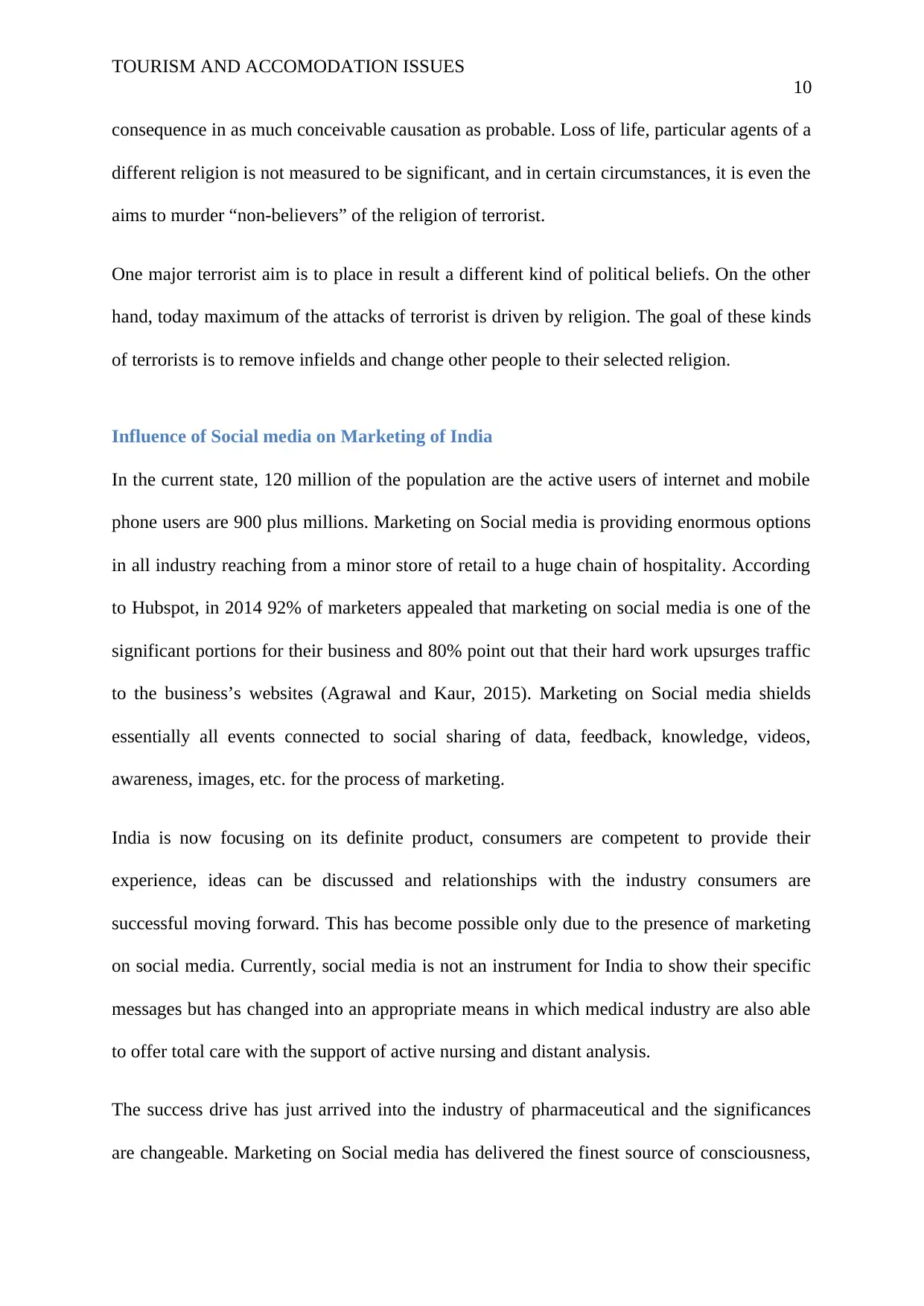
TOURISM AND ACCOMODATION ISSUES
10
consequence in as much conceivable causation as probable. Loss of life, particular agents of a
different religion is not measured to be significant, and in certain circumstances, it is even the
aims to murder “non-believers” of the religion of terrorist.
One major terrorist aim is to place in result a different kind of political beliefs. On the other
hand, today maximum of the attacks of terrorist is driven by religion. The goal of these kinds
of terrorists is to remove infields and change other people to their selected religion.
Influence of Social media on Marketing of India
In the current state, 120 million of the population are the active users of internet and mobile
phone users are 900 plus millions. Marketing on Social media is providing enormous options
in all industry reaching from a minor store of retail to a huge chain of hospitality. According
to Hubspot, in 2014 92% of marketers appealed that marketing on social media is one of the
significant portions for their business and 80% point out that their hard work upsurges traffic
to the business’s websites (Agrawal and Kaur, 2015). Marketing on Social media shields
essentially all events connected to social sharing of data, feedback, knowledge, videos,
awareness, images, etc. for the process of marketing.
India is now focusing on its definite product, consumers are competent to provide their
experience, ideas can be discussed and relationships with the industry consumers are
successful moving forward. This has become possible only due to the presence of marketing
on social media. Currently, social media is not an instrument for India to show their specific
messages but has changed into an appropriate means in which medical industry are also able
to offer total care with the support of active nursing and distant analysis.
The success drive has just arrived into the industry of pharmaceutical and the significances
are changeable. Marketing on Social media has delivered the finest source of consciousness,
10
consequence in as much conceivable causation as probable. Loss of life, particular agents of a
different religion is not measured to be significant, and in certain circumstances, it is even the
aims to murder “non-believers” of the religion of terrorist.
One major terrorist aim is to place in result a different kind of political beliefs. On the other
hand, today maximum of the attacks of terrorist is driven by religion. The goal of these kinds
of terrorists is to remove infields and change other people to their selected religion.
Influence of Social media on Marketing of India
In the current state, 120 million of the population are the active users of internet and mobile
phone users are 900 plus millions. Marketing on Social media is providing enormous options
in all industry reaching from a minor store of retail to a huge chain of hospitality. According
to Hubspot, in 2014 92% of marketers appealed that marketing on social media is one of the
significant portions for their business and 80% point out that their hard work upsurges traffic
to the business’s websites (Agrawal and Kaur, 2015). Marketing on Social media shields
essentially all events connected to social sharing of data, feedback, knowledge, videos,
awareness, images, etc. for the process of marketing.
India is now focusing on its definite product, consumers are competent to provide their
experience, ideas can be discussed and relationships with the industry consumers are
successful moving forward. This has become possible only due to the presence of marketing
on social media. Currently, social media is not an instrument for India to show their specific
messages but has changed into an appropriate means in which medical industry are also able
to offer total care with the support of active nursing and distant analysis.
The success drive has just arrived into the industry of pharmaceutical and the significances
are changeable. Marketing on Social media has delivered the finest source of consciousness,
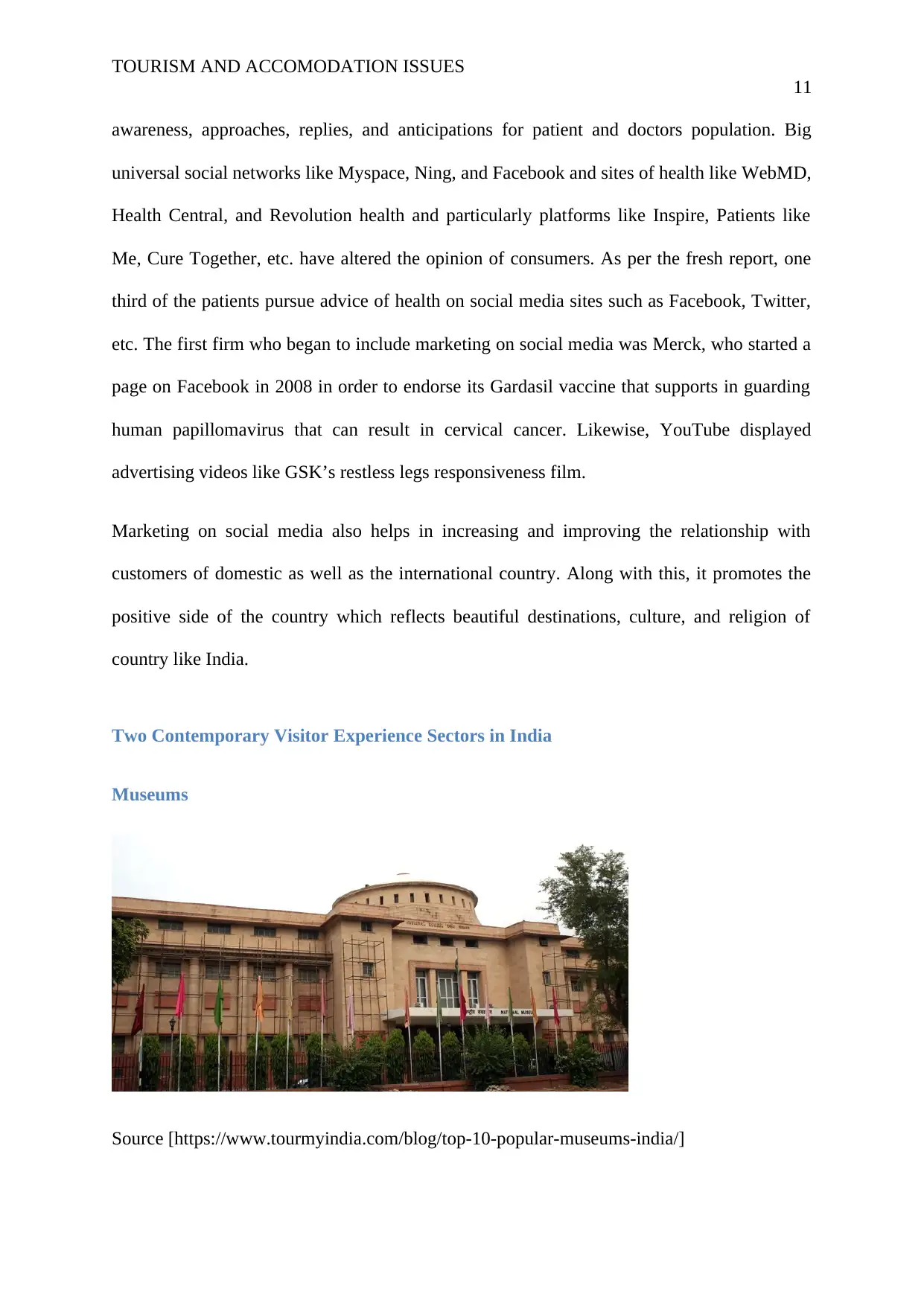
TOURISM AND ACCOMODATION ISSUES
11
awareness, approaches, replies, and anticipations for patient and doctors population. Big
universal social networks like Myspace, Ning, and Facebook and sites of health like WebMD,
Health Central, and Revolution health and particularly platforms like Inspire, Patients like
Me, Cure Together, etc. have altered the opinion of consumers. As per the fresh report, one
third of the patients pursue advice of health on social media sites such as Facebook, Twitter,
etc. The first firm who began to include marketing on social media was Merck, who started a
page on Facebook in 2008 in order to endorse its Gardasil vaccine that supports in guarding
human papillomavirus that can result in cervical cancer. Likewise, YouTube displayed
advertising videos like GSK’s restless legs responsiveness film.
Marketing on social media also helps in increasing and improving the relationship with
customers of domestic as well as the international country. Along with this, it promotes the
positive side of the country which reflects beautiful destinations, culture, and religion of
country like India.
Two Contemporary Visitor Experience Sectors in India
Museums
Source [https://www.tourmyindia.com/blog/top-10-popular-museums-india/]
11
awareness, approaches, replies, and anticipations for patient and doctors population. Big
universal social networks like Myspace, Ning, and Facebook and sites of health like WebMD,
Health Central, and Revolution health and particularly platforms like Inspire, Patients like
Me, Cure Together, etc. have altered the opinion of consumers. As per the fresh report, one
third of the patients pursue advice of health on social media sites such as Facebook, Twitter,
etc. The first firm who began to include marketing on social media was Merck, who started a
page on Facebook in 2008 in order to endorse its Gardasil vaccine that supports in guarding
human papillomavirus that can result in cervical cancer. Likewise, YouTube displayed
advertising videos like GSK’s restless legs responsiveness film.
Marketing on social media also helps in increasing and improving the relationship with
customers of domestic as well as the international country. Along with this, it promotes the
positive side of the country which reflects beautiful destinations, culture, and religion of
country like India.
Two Contemporary Visitor Experience Sectors in India
Museums
Source [https://www.tourmyindia.com/blog/top-10-popular-museums-india/]
⊘ This is a preview!⊘
Do you want full access?
Subscribe today to unlock all pages.

Trusted by 1+ million students worldwide
1 out of 18
Related Documents
Your All-in-One AI-Powered Toolkit for Academic Success.
+13062052269
info@desklib.com
Available 24*7 on WhatsApp / Email
![[object Object]](/_next/static/media/star-bottom.7253800d.svg)
Unlock your academic potential
Copyright © 2020–2025 A2Z Services. All Rights Reserved. Developed and managed by ZUCOL.





